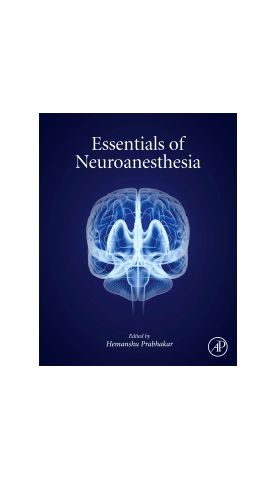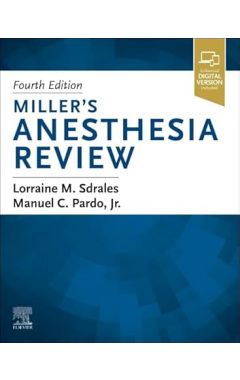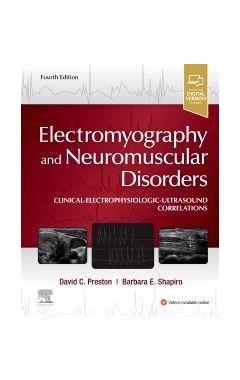Section I. Neuroanatomy
Chapter 1. Neuroanatomy
- Introduction
- Embryological Differentiation of Different Parts of Brain
- Anatomy of Brain
- Vascular Supply of the Brain
- The Meninges and Cerebrospinal Fluid
Chapter 2. Neuroembryology
- Formation of Zygote
- Formation of Blastocyst
- Formation of Embryonic or Germ Disc
- Formation of Definitive Notochord
- Development of Nervous System
Chapter 3. Blood–Brain Barrier
- Introduction
- Permeability at the Blood–Brain Barrier
- Cellular and Molecular Effects of Anesthetics on the Blood–Brain Barrier
- Clinical and Experimental Implications of Anesthetics on the Blood–Brain Barrier
- Conclusion
Section II. Neurophysiology
Chapter 4. Neurophysiology
- Intracranial Pressure
- Normal Intracranial Pressure
- Cerebral Compliance
- Importance of Intracranial Pressure
- Summary
- Cerebral Blood Flow
- Vascular Anatomy
- Summary
- Brain Metabolism
- Normal Cerebral Metabolism
- Summary
- Cerebrospinal Fluid
- Ventricular System
- Summary
- The Spinal Cord
- Anatomy
- Organization of the Spinal Cord
- Summary
Chapter 5. Brain Protection in Neurosurgery
- Introduction
- Nonpharmacological Strategies
- Mild Hypothermia
- Blood Pressure Control
- Induced Arterial Hypertension
- Normoglycemia
- Target Hemoglobin Concentration
- Pharmacological Strategies
- Nonanesthetic Agents
- Anesthetic Agents
- Conclusion
Section III. Neuropharmacology
Chapter 6. Neuropharmacology
- Anesthetic Drugs and Sedatives
- Intravenous Anesthetic Agents
- Inhalational Anesthetic Agents
- Neuromuscular Blocking Agents
- Local Anesthetic Agents
- Miscellaneous Drugs
- Future Directions in Neuropharmacology
- Conclusion
Chapter 7. Anesthetic Agents: Neurotoxics or Neuroprotectives?
- Introduction
- Pharmacological Considerations
- Anesthesia Practice: Clinical Outcomes
- Anesthesia and Fragile Brain
- Conclusion
- Abbreviations
Section IV. Neuromonitoring
Chapter 8. Neuromonitoring
- Introduction
- Cerebral Blood Flow
- Transcranial Sonography
- Thermal Diffusion Flowmetry
- Laser Doppler Flowmetry
- Intra-Arterial 133Xenon
- CT Perfusion
- Xenon Enhanced CT
- Positron Emission Tomography
- Single Photon Emission Computed Tomography
- Magnetic Resonance Imaging
- Intracranial Pressure
- Electroencephalogram
- Evoked Potential Monitoring
- Motor Evoked Potentials
- Depth of Anesthesia
- Cerebral Oxygenation Monitoring
- Jugular Venous Oximetry
- Regional Cerebral Oximetry
- Brain Tissue Oxygen Monitoring
- Cerebral Microdialysis
- Conclusion
Chapter 9. Multimodal Monitoring
- Introduction
- Temperature
- Oxygen Transport, Hemodynamics, and Brain Metabolism
- Intracranial Pressure Monitoring
- Electroencephalography and Depth of Anesthesia Monitoring
- Miscellaneous
- Integration of Information and Decision-Helping Systems
- Clinical Pearls
Section V. Positions in Neurosurgery
Chapter 10. Positioning in Neurosurgery
- Introduction
- Historical Background
- Principles of Positioning
- The Conduct of Positioning
- Surgical Approach for Craniotomies
- Positioning for Craniotomy
- Positions Used for Craniotomies
- Surgical Approach for Procedures of the Spine
- Conclusion
- Abbreviations
Section VI. Preanesthetic Evaluation
Chapter 11. Preanesthetic Evaluation of Neurosurgical Patients
- Introduction
- Preoperative Evaluation of Patient-Related Risk Factors
- Preoperative Evaluation of Specific Neurosurgical Conditions
Section VII. Neurosurgery
Chapter 12. Supratentorial Lesions
- Introduction
- Classification
- Pathophysiology and Clinical Correlations
- Clinical Features
- Neuroimaging
- Intraoperative Considerations: The Team Approach
- Anesthetic Management
- Intraoperative Management
- Emergence From Anesthesia
- Postoperative Management
- Awake Craniotomy
- Conclusions
Chapter 13. Emergence From Anesthesia
- Introduction
- Neurophysiological Response During Emergence in Neurosurgical Patients
- Specific Perioperative Considerations
- Delayed Emergence and Arousal
- Complications
- Conclusion
Chapter 14. Anesthesia for Posterior Fossa Surgery
- Introduction
- Anatomy
- Clinical Presentation
- Perioperative Management of Patients for Posterior Fossa Surgery
- Venous Air Embolism
- Postoperative Management
- Complications
- Abbreviations
Chapter 15. Transesophageal Echocardiography
- Introduction
- Basics of Transesophageal Echocardiography
- Summary
Chapter 16. Anesthesia for Epilepsy Surgery
- Introduction
- Surgical Management of Epilepsy
- Types of Surgical Treatment
- Presurgical Evaluation
- Anesthesia for Epilepsy Surgery
- Effect of Anesthetic Agents in Patients With Epilepsy
- Antiepileptic Drug Interactions
- Preanesthetic Evaluation and Preparation
- Anesthetic Management of Preoperative Procedures
- Anesthesia for Intracranial Electrode Insertion
- Anesthetic Management of Resection of Seizure Focus
- Awake Craniotomy
- Resection of Epileptogenic Focus Under General Anesthesia
- Neurostimulation for Drug-Resistant Epilepsy
- Anesthetic Management of the Patient With Epilepsy for Incidental Surgery
- Abbreviations
Chapter 17. Refractory Status Epilepticus
- Introduction
- Epidemiology
- Classification
- Cause
- Pathophysiology
- Diagnosis
- Management
- Treatment
- Conclusions
Chapter 18. Aneurysmal Subarachnoid Hemorrhage
- History
- Introduction
- Clinical Presentation and Diagnosis
- Grading of Subarachnoid Hemorrhage
- Initial Management Concerns in Neurocritical Care Unit
- Timing of Surgery
- Clipping or Coiling
- Evaluation of a Patient With Subarachnoid Hemorrhage for Anesthesia
- Anesthetic Management
- Temporary Clipping and Brain Protection Strategy
- Intraoperative Aneurysm Rupture
- Giant Aneurysms and Circulatory Arrest
- Endovascular Management for Aneurysm Ablation
- Postoperative Management of Patients
- Conclusion
Chapter 19. Circulatory Arrest
- Introduction
- Deep Hypothermic Circulatory Arrest
- Anesthesia Management
- Complications
- Adenosine-Induced Circulatory Arrest
- Anesthesia Considerations
- Complications
- Summary
Chapter 20. Cerebrovascular Disease
- Intracerebral Hemorrhage
- Incidence and Risk Factors
- Imaging
- Clinical Presentation
- Management of Intracerebral Hemorrhage
- Arteriovenous Malformations
- Cause and Incidence
- Natural History
- Pathophysiologic Effects and Clinical Presentation
- Grading of Arteriovenous Malformations
- Imaging
- Cerebral Hemodynamics in Arteriovenous Malformation
- Management
- Surgical Resection of Arteriovenous Malformation
- Anesthetic Considerations for Resection of Arteriovenous Malformation
- Postoperative Management
- Anesthetic Considerations for Arteriovenous Malformation Embolization
- Complications During Arteriovenous Malformation Embolization
- Pediatric Arteriovenous Malformations
- Pregnancy and Arteriovenous Malformations
- Vein of Galen Aneurysmal Malformations
- Dural Arteriovenous Fistula
- Clinical Presentation
- Management
- Carotid Endarterectomy
- Preoperative Evaluation
- Management of Carotid Artery Disease
- Monitoring
- Intraoperative Management
- Postoperative Complications and Outcomes
- Coronary Angioplasty and Stenting
- Moyamoya Disease
- Management of Moyamoya Disease
Chapter 21. Flow Arrest in Cerebrovascular Surgery
- Deep Hypothermic Circulatory Arrest
- Adenosine-Assisted Cerebral Blood Flow Arrest
- Rapid Ventricular Pacing–Assisted Cerebral Blood Flow Arrest
Chapter 22. Neuroendocrine Lesions
- Hypothalamic-Pituitary–Adrenal Axis Evaluation
- Neuroendocrine Response Related to Anesthesia and Surgery
- Pituitary Gland Adenomas
- Physiology of Pituitary Gland
- Endocrine Diseases
- Nonfunctioning Tumors
- Intraoperative Considerations
- Advantages of Endoscopic Endonasal Approach
- Relative Contraindications to Transsphenoidal Approach
- Intraoperative Issues
- Disorder of Water and Electrolytes
Chapter 23. Pituitary Apoplexy
- Clinical Features
- Management
Chapter 24. Spinal Surgery
- Introduction
- Spine
- Types of Spine Surgeries
- Surgical Approaches to the Spine
- Common Spine Disorders
- Imaging in Spine Lesions
- Positioning for Spine Surgeries
- Neurophysiological Intraoperative Monitoring During Spine Surgeries
- Preanesthetic Assessment and Optimization
- Anesthesia Management
- Postoperative Management
- Special Considerations
- Conclusion
Chapter 25. Postoperative Visual Loss
- Introduction
- Central Retinal Artery Occlusion
- Ischemic Optic Neuropathy
- Cortical Blindness
- Recent Advances
- Conclusion
Chapter 26. Neuroendoscopy
- Introduction
- Anesthetic Goals and Management
- Anesthetic Management of Specific Neuroendoscopic Procedures
- Advances in Neuroendoscopy
- Conclusion
- Clinical Pearls
Chapter 27. Pressure Inside the Neuroendoscope
- Introduction
- Indications and Procedures
- How Do Neurosurgeons Perform an Intraventricular Endoscopic Procedure?
- Anesthetic Procedure: What to Take Into Account?
- Perioperative Complications
- Conclusion
Chapter 28. Anesthesia for Functional Neurosurgery
- Introduction
- Procedure
- Anesthetic Consideration
- Anesthetic Techniques
- Complications
- Anesthesia in Patients With Deep Brain Stimulator In Situ
- Conclusion
Chapter 29. Awake Craniotomy
- Introduction
- Patient Selection
- Awake Craniotomy for Tumor Surgery
- Awake Craniotomy for Epilepsy
- Conclusion
Section VIII. Neuroradiology
Chapter 30. Anesthesia for Neuroradiology
- Introduction
- Issues Relating to Anesthesia Care in Neuroradiology
- Anesthesia for Computed Tomographic Study
- Anesthesia for Magnetic Resonance Imaging Study
- Anesthesia for Diagnostic Angiography
- Anesthetic Management of Endovascular Coiling
- Anesthetic Management of Endovascular Embolization of Arteriovenous Malformation, Arteriovenous Fistula, and Vein of Galen Malformation
- Anesthesia for Stroke Interventions
- Issues Related to Radiation During Neurointervention
- Anesthesia for Stereotactic Radiosurgery
- Pregnancy and Neuroradiology
- Clinical Pearls
Chapter 31. Magnetic Resonance Imaging: Anesthetic Implications
- Introduction: The Road From X-Ray to Magnetic Resonance Imaging
- Principles of Nuclear Magnetic Resonance and Magnetic Resonance Imaging
- Various Types of Signals Recorded
- Hazards Related to Magnetic Resonance Imaging
- Magnetic Resonance Imaging Safety: General Considerations
- Magnetic Resonance Imaging Safety: Management of Cardiac Implantable Electronic Devices and Other Implantable Devices
- Anesthesia for Magnetic Resonance Imaging
- Research Applications/Emerging Clinical Applications of Magnetic Resonance Imaging
Section IX. Neurotrauma
Chapter 32. Neurotrauma
- Traumatic Brain Injury
- Definition
- Epidemiology
- Classification of Traumatic Brain Injury
- Physiologic Response to Brain Injury
- Neuroimaging
- Severity of Traumatic Brain Injury
- Management of Traumatic Brain Injury
- Outcome
- Emerging Treatment Modalities
- Conclusion
- Spine and Spinal Cord Trauma
- Epidemiology
- Classification of Spinal Injury
- Pathophysiology of Spinal Cord Trauma
- Systemic Complications of Spinal Cord Injuries
- Management of Spine and Spinal Cord Injury
- Emerging Treatment Modalities
Chapter 33. Biomarkers in Traumatic Brain Injury
Section X. Neurointensive Care
Chapter 34. Neurological Critical Care
- Introduction
- History of Neurocritical Care
- Design of a Neurocritical Care Unit
- Clinical Conditions Requiring Admission to Neurocritical Care Unit
- Justification for Neurological Critical Care Units
- Pathophysiological Issues in Neurological Critical Care
- Management of Patients in a Neurological Intensive Care Unit
- Management of General Systemic Physiology
- Specific Therapeutic Issues in Individual Clinical Conditions
- Advanced Neuromonitoring
- Outcomes of Neurological Intensive Care Unit
- End-of-Life Issues in Neurological Critical Care
- Clinical Pearls
Chapter 35. Antibiotics: Prophylactic and Therapeutics
- Introduction
- Principles of Antimicrobial Therapy in Neurosurgery
- Treatment of Central Nervous System Infections in the Neurosurgical Patient
- Antimicrobial Prophylaxis in Neurosurgery
Section XI. Special Considerations
Chapter 36. Pediatric Neuroanesthesia
- Overview
- Pediatric Neurophysiology
- General Principles of Pediatric Neuroanesthesia
- Intraoperative Management
- Postoperative Considerations
- Management of Specific Conditions
- Conclusion
Chapter 37. Fluid and Blood Transfusion in Pediatric Neurosurgery
- Introduction
- Fluid and Electrolyte Choices
- Type of Fluids for Perioperative Administration in Pediatric Patients
- Fluid Management in Pediatric Neurosurgery
- Osmotherapy
- Fluid and Electrolyte Disturbances in Pediatric Neurosurgery
- Blood Transfusion
- Blood Components
- Special Situations
- Epilepsy Surgery
- Scoliosis
- Conclusion
Chapter 38. Geriatric Neuroanesthesia
- Introduction
- Implications of Surgical Stress and Anesthesia on the Elderly
- Neurosurgical Concerns Unique to the Elderly
- Conclusion
Chapter 39. Postoperative Cognitive Dysfunction
- Introduction
- Definitions, Epidemiology, and Pathophysiology
- Risk Factors
- Prevention
- Screening Tools
- Treatment
- Outcome
Chapter 40. Pregnancy
- Requirement of Neurosurgery During Pregnancy
- Physiological Alterations During Pregnancy
- Effect of Anesthetic Agents on Fetal Outcome
- Uteroplacental Drug Transfer and Neonatal Depression
- Timing and Method of Delivery
- Anesthetic Considerations During Pregnancy
- Induction: Rapid Sequence Versus Slow Neuroinduction
- Combined Cesarean Delivery and Neurosurgery
- Intracranial Pressure and Regional Anesthesia
- Postoperative Management
- Anesthesia for Interventional Neurosurgical Procedures
Chapter 41. Cerebral Venous Thrombosis
- Definition
- Venous Anatomy
- Incidence of Cerebral Venous Thrombosis
- Risk Factors
- Pathophysiology
- Clinical Manifestations
- Diagnostic Evaluation
- Treatment
- Anesthetic Management
- Prognosis
- Conclusion
Chapter 42. Neurosurgical Anesthesia in Patients With Coexisting Cardiac Disease
- Introduction
- Preoperative Evaluation
- Risk Stratification
- Perioperative Monitoring
- Ischemic Heart Disease
- Valvular Heart Disease
- Tumors of the Heart
- Congenital Heart Disease
- Hypertension
- Conclusion
Chapter 43. Intraoperative Cardiopulmonary Resuscitation
- Introduction
- Incidence, Morbidity, and Mortality
- Survival From Intraoperative Cardiac Arrest
- Predictors
- Cause of Intraoperative Cardiac Arrest
- Cardiopulmonary Resuscitation Quality
- Cardiac Arrest and Cardiopulmonary Resuscitation in Neurosurgical Patients
- Prognosis
- Conclusion
Chapter 44. Coexisting Diabetes Mellitus in Neurosurgical Patients
- Introduction
- Incidence of Diabetes Mellitus
- Glycemic Indices
- Modes of Glucose Measurement
- Pathophysiology of Diabetes Mellitus
- Cerebral Glucose Metabolism
- Hyperglycemia and the Brain
- Hyperglycemic Neuropathy
- Diabetic Dysautonomia
- Hypoglycemia and the Brain
- Evidence of Glycemic Control in Important Neurosurgical Subsets
- Traumatic Brain Injury
- Subarachnoid Hemorrhage
- Cerebrovascular Accidents
- Tumor Surgery
- Spine Surgery
- Blood Sugar Management in Perioperative Period and Neurocritical Care
- Intraoperative Management
- Anesthetic Management
- Postoperative Glycemic Management
- Blood Sugar Control in Emergency Neurosurgical Patient
- Blood Sugar Control in Intensive Care Setup
- Nutrition
- Conclusions
- Coexisting Hypertension in Neurosurgical Patients
- Physiology of Cerebral Circulation
- Pathophysiology of Arterial Hypertension
- Hypertension in Patients With Traumatic Brain Injury
- Perioperative Management
- Preoperative Evaluation
- Antihypertensive Drugs
- Intraoperative Management
- Monitoring
- Induction of Anesthesia
- Maintenance of Anesthesia
- Recovery From Anesthesia
- Postoperative Care
- Neurocritical Care
- Conclusion
Chapter 45. Neuromuscular Disorders
- Introduction
- Myasthenia Gravis
- Myasthenic Crisis
- Lambert–Eaton Myasthenic Syndrome
- Guillain–Barré Syndrome
- Periodic Paralysis
- Myotonias
- Muscular Dystrophies
- Motor Neuron Diseases
- Multiple Sclerosis
- Parkinson’s Disease
- Alzheimer’s Disease
- Huntington’s Disease
Chapter 46. Neuromuscular Electrical Stimulation in Critically Ill Patients
- Introduction
- Neuromuscular Electrical Stimulation: Basic Concepts and Practical Considerations
- Neuromuscular Electrical Stimulation in the Intensive Care Unit
- Contraindications and Adverse Effects
- Recommendations for the Use of Neuromuscular Electrical Stimulation in the Intensive Care Unit
Chapter 47. Neurological Patients for Nonneurosurgeries
- Neurodegenerative Diseases
- Demyelinating Disease
- Neuromuscular Disease: Myasthenia Gravis
- Epilepsy
- Intracranial Tumors
- Traumatic Brain Injury
Chapter 48. Anesthesia for Electroconvulsive Therapy
- Background
- Technique of Electroconvulsive Therapy
- Contraindications
- Preprocedure Management
- Anesthesia for Electroconvulsive Therapy
- Side Effects
- Special Conditions
- Conclusion
Section XII. Fluids and Electrolyte Management
Chapter 49. Fluids and Electrolyte Management
- Introduction
- Anatomy and Physiology
- Pathophysiology
- Definitions
- Choice of Fluids
- Hypertonic Fluids
- Isotonic Fluids
- Colloids
- Hypotonic Fluids
- Fluid Management
- Commonly Encountered Fluid Abnormalities
- Conclusion
- Clinical Pearls
Chapter 50. Crystalloid and Colloid Fluids
- Crystalloid Fluids
- Colloid Fluids
- Which Fluid to Choose?
- Conclusions
Section XIII. Pain Management
Chapter 51. Pain Management
- Postcraniotomy Pain
- Incidence
- Anatomical and Physiological Basis of Pain Following Craniotomy
- Pain-Sensitive Structures of Cranium
- Pathogenesis of Postcraniotomy Pain
- Factors Affecting Postcraniotomy Pain
- Classification and Assessment of Postcraniotomy Pain
- Preemption of Pain
- Treatment of Acute Pain
- Postcraniotomy Pain Management in the Pediatric Population
- Conclusion
- Acute Pain Management After Spinal Surgery
- Pathophysiology
- Treatment Modalities for Acute Postoperative Spinal Pain
- Conclusion
Section XIV. Brain Death and Ethical Issues
Chapter 52. Brain Death and Ethical Issues in Neuroanesthesia Practice
- Part A: Brain Death
- Criteria for Diagnosing Death
- Need for Brain Death Diagnosis
- Rules Regulating Diagnosis of Brain Death
- Criteria for Certifying Brain Stem Death
- Pitfalls/Controversies
- Conclusion
- Appendix I
- Part B: Ethical Issues in Neuroanesthesia Practice
- Ethical Issues in Clinical Care
- Ethical Issues Related to Research
- Ethical Issues Related to Team Work
- Ethical Issues Related to Training
- Ethical Issues Related to Innovative Neurosurgery
- Conclusion
Chapter 53. Organ Donation
Section XV. Evidence-Based Practice
Chapter 54. Evidence-Based Practice of Neuroanesthesia
- Introduction
- Evidence-Based Practice and Neuroanesthesia
- Evidence and the Brain Trauma Foundation Guidelines
- Unresolved Issues in the Practice of Neuroanesthesia
- Conclusion
- Clinical Pearls
Chapter 55. Translational Research
- Introduction
- Definition
- In Neuroanesthesia
- Why Not Lead to Clinical
- To Be a Successful Translation
- Conclusion
Section XVI. Recent Advances
Chapter 56. Recent Advances in Neuroanesthesiology
- Introduction
- Endovascular Treatment of Stroke and Perioperative Stroke
- Indications for Deep Brain Stimulation
- Anesthetic Neurotoxicity
- Pre- and Postconditioning
- Brain Monitoring
- New Assays for Creutzfeldt–Jakob Disease
Chapter 57. Stem Cell Therapy
- Hypothesis of Stem Cell Research
- Stem Cell
- Historical Background
- Types of Stem Cells
- Sources of Stem Cells
- Mesenchymal Stem Cells
- Stem Cells in Neurological Diseases
- Mode of Action of Stem Cell Therapy
- Ethical Issues
- Recent Advances
Chapter 58. Pharmacogenomics
- Introduction
- Basic Genetic Principles
- Basic Pharmacologic Principles
- Anesthesia Contribution to the History of Pharmacogenomics
- Pharmacogenomics: Current Application to Clinical Anesthesia
- Conclusion
Section XVII. Sterilization Techniques
Chapter 59. Sterilization and Disinfection
- Background
- Recommendation of Preferred Methods for Various Medical Devices
- Recommendation for the Cleaning and Decontamination of Environmental Surfaces
- Recommendation for Blood Spill on the Surface
- Cleaning and Disinfection of Medical Instruments
- Cleaning and Reprocessing of Patient Care Equipment
- Reprocessing of Respiratory Apparatus and Endoscopes
- Reprocessing of Endoscopes
- Specific Issues
- Special Precaution for Inactivation of Creutzfeldt–Jakob Disease
- Health Care–Associated Infections
- Infections in Operating Rooms and Intensive Care Units
- Conclusion
Chapter 60. Universal Precautions in the Intensive Care Unit
- Introduction
- Prophylactics of Health Care–Associated Infections in the Intensive Care Unit
- Early Diagnosis of Pathogens and Infection Complications in the Intensive Care Unit
- Rational Antibiotic Therapy
- Systemic Approach
- Conclusion
Section XVIII. Palliative Care
Chapter 61. Palliative Care to Neurological and Neurosurgical Patients
Chapter 62. Quality of Life and Health-Related Issues
- Introduction
- Quality of Life and Health-Related Quality of Life
- Utility of Health-Related Quality of Life
- Tools for Measuring Health-Related Quality of Life
- Uses of Measuring Health-Related Quality of Life
- Health-Related Quality of Life in Relation to Neurosurgical/Neurological Conditions
- Conclusion
Section XIX. Biostatistics
Chapter 63. Biostatistics
- Introduction to Biostatistics
- Definition of Statistics
- Biostatistics and Its Applications
- Uses of Statistical Methods in Medical Sciences
- Some Basic Statistical Concepts
- Population and Sample
- Scale of Measurements
- Constant
- Variables
- Parameter and Statistic
- Ratio, Proportion, and Rate
- Statistical Inference
- Estimation
- Hypothesis Testing
- Steps in Hypothesis Testing or Testing the Statistical Significance
- Defining the Null and Alternative Hypotheses
- Calculating the Test Statistic
- Obtaining, Using, and Interpreting the p-Value
- Errors in Hypothesis Testing
- The Possible Mistakes We Can Make
- Other Important Concepts That are Essential in Statistical Inference
- Parametric and Nonparametric Statistical Methods
- Basic Principles of Statistics
- Probability Distributions
- Study Design
- Sample Size
- Data Collection and Preparing Data for Analysis
- Analysis and Presentation of Data
- Summarizing Data
- Comparing Groups: Continuous Data
- Comparing Groups: Categorical Data
- Comparing Groups: Time to Event Data
- Relation Between Two Continuous Variables
- Multivariable Analysis
- Conclusion







Login and Registration Form